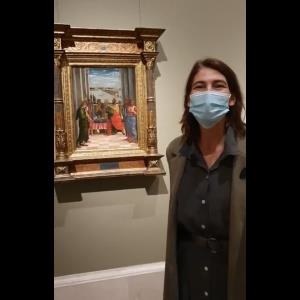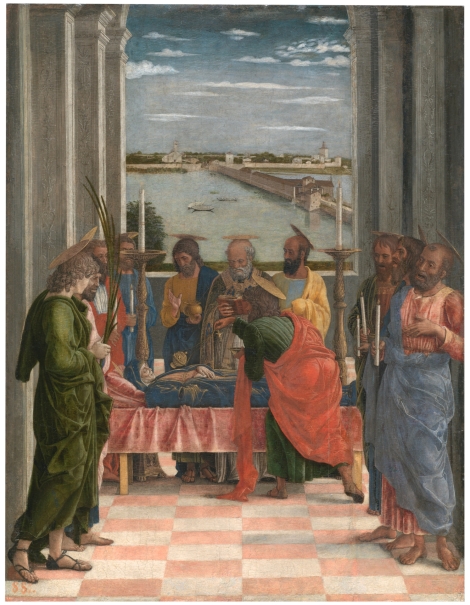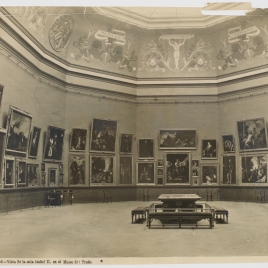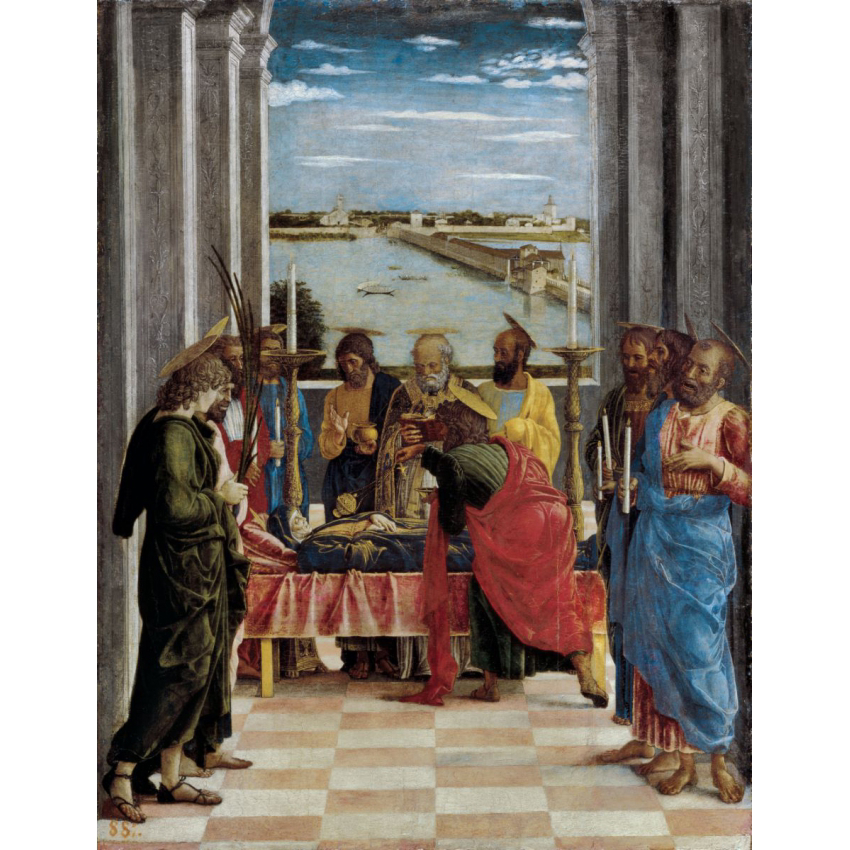Bibliography +
Tubino, F.M, La escuela pictórica veneciana desde Mantegna y los Bellini hasta TIziano a propósito de una tabla de Mantegna...., Museo español de antiguedades, 7, 1876, pp. 157.
Mantz, P., Andrea Mantegna, Gazette des Beaux-arts, 33/34, 1886, pp. 484.
Lefort, P., Les museés de Madrid. Le museé du Prado. La peinture italienne, les venetiens, Gazette des beaux-arts, 7/8, 1892, pp. 460.
Frizzoni, F., Capolavori della pinacoteca del Prado in Madrid, Archivio storico dell arte, 5/6, 1893, pp. 288.
Tholde, Henry, Mantegna, Velhagen & klasing, Bielefeld. Leipzig, 1897, pp. 48.
Casola, Pietro, Canon Pietro Casola's pilgrimage to Jerusalem in the year 1494, M.M.Newett, Manchester, 1907, pp. 22.
Berenson, Bernard, North Italian Painters of the Renaissance, G.P.Putnam's Sons, Nueva York Londres, 1907, pp. 254.
Knapp, F., Andrea Mantegna. Des meisters gemalde, Deutsche verlags-Anstalt, Stuttgart Leipzig, 1910, pp. 41.
Andrea Mantegna. L'oeuvre du Maîttre, Hachette, Paris, 1911, pp. 91.
Cartwright,Julia, Isabelle D'Este Marquise de Mantove 1474-1539., Hachette, Paris, 1912, pp. 56.
Dayot, Armand, Le Prado de Madrid. Vol. I, I, Editions Pierre Lafitte, Paris, 1914, pp. 51.
Venturi, Adolfo, Storia dell' arte italiana, U. Hoepli, Milán, 1914.
Beroqui, Pedro, Adiciones y correcciones al catálogo del museo del Prado, Boletin de la Sociedad Española de Excursiones, 23, 1915, pp. 181.
Testi, Laudedeo, La storia della pittura veneziana.Vol.II. Divenire, Istituto italiano d'arti grafiche, Bergamo, 1915, pp. 46-59.
Venturi, A., Giamballino. Nuove ricerche, L'Arte, 24, 1924, pp. 137.
Fiocco, Giuseppe, L'Arte di Andrea Mantegna, Casa editrice apollo, Bolonia, 1927.
Longhi, Roberto, Risarcimento di un Mantegna, Bruckmanns pantheon, 13-14, 1934, pp. 503-512.
Fiocco, G., Mantegna con 200 tavole, Milán, 1937, pp. 48.
Noul, M., Sotomayor, F., Muguruza, P., Les chefs-d'oeuvre du Musée du Prado, Musée d'Art et d'Histoire, Ginebra, 1939, pp. 33.
Hartt, F., The earliest works of the Andrea del Castagno, The Art Bulletin, 41, 1959, pp. 226.
Paccagnini,G. Mezzetti,A. Figlioli, M. et al, Andrea Mantegna, Comitatto della mostra, Mantua, 1961, pp. 35,36/ lám.32.
Gilbert, C, The Mantegna exhibition, The Burlington magazine, 104, 1962, pp. 5.
Cipriani, R., Tutte la pittura del Mantegna, Milán, 1962.
Tüngel, Richard, 400 Jahre Kunst, Kultur, und Geschichte im Prado, Schweizer Verlagshaus, Zurich, 1964, pp. lám.106.
Longhi, Roberto, Edizione delle Opere Complete di Roberto Longhi., IV, Sansoni, Florencia, 1968, pp. lám.120.
Berenson, Bernard, Italian pictures of the Renaissance: a list of the principal, I, Phaidon, Londres, 1968, pp. 248.
New International Illustrated Encyclopedia of Art, Greystone Press, Nueva York-Toronto, 1969, pp. 2711.
Bellonci, Maria Garavaglia, Niny, La Obra pictórica completa de Mantegna, Noguer, Barcelona Madrid, 1970.
Andrea Mantegna 1431-1504: [E la Sua Bottega], L'Arte Antica [Etc.], 1971, pp. 184-186.
Bocazzi, F., Mantegna, 1972, pp. 33.
Sánchez Cantón, Francisco Javier, Museo del Prado. Catálogo de las pinturas, Museo del Prado, Madrid, 1972.
Millar, Oliver, The Queen's Pictures, Chancellor Press, Londres, 1977, pp. 43/ lám.39.
Museo Nacional del Prado, Museo del Prado: pintura italiana anterior a 1600, Gredos, Madrid, 1979, pp. 62-65.
Martindale, Andrew, The Triumphs os Caesar by Andrea Mantegna in the collection of...the Queen at Hampton Court, Harvey Miller, Londres, 1979, pp. lám.142.
Ramírez, Juan Antonio, Construcciones ilusorias: (arquitecturas descritas, arquitec, Alianza, Madrid, 1983, pp. 76 Lám.49.
Greindl, Edith, Les peintres flamands de nature morte au XVII siecle, Editions D'Art Michel Lefebvre, Paris, 1983, pp. 101.
Burke, Marcus B., Private Collections of Italian Art in Seventeenth Century Sp, I, University Microfilm International, Nueva York, 1984, pp. 119.
Museo Nacional del Prado, Catálogo de las pinturas, Museo del Prado, Madrid, 1985, pp. 392.
Carroggio, Fernando, Historia del arte, V, CarroggioS.A., Barcelona, 1985, pp. 114.
Vicens, Maria Teresa, Iconografia Assumpcionista, Direcció General de Cultura, Valencia, 1986, pp. 74.
Lightbown, Ronald, Mantegna with a complete catalogue of the paintings, drawings and prints, Phaidon Christie's, Oxford, 1986, pp. 414 Lám.53.
Bertelli, C., Storia Dell'Arte Italiana. Vol. I, I, ElectaBruno Mondadori, Milán, 1986, pp. 382.
Argan, Giulio Carlo, Renacimiento y barroco, Akal, Madrid, 1987, pp. 282,320 lám.348.
La Pittura nel VenetoIl Quattrocento, II, Electa, Milán, 1989.
Doce artistas de vanguardia en el Museo del Prado:Saura, Bar, Mondadori, Madrid, 1990, pp. 193.
Museo Nacional del Prado, Museo del Prado. Inventario general de pinturas (I) La Colección Real, Museo del Prado, Espasa Calpe, Madrid, 1990.
Boorsch,S. Christiansen,K. Ekserdjian, D. et al., Andrea Mantegna, Olivetti-Electa, Nueva York Londres, 1992, pp. 159-163.
Martineau, Jane, Andrea Mantegna, Electa - Thames and Hudson, Londres, 1992, pp. 150-163.
Barrio-Garay, J.L, Cronica de Nueva York: Andrea Mantegna en el Metropolitan, Goya: Revista de Arte, 229-230, 1992, pp. 102.
Lightbown, Ronald., Exhibition reviews. Mantegna great but little knoown, Apollo, CXXXV, 1992, pp. 189.
Buendía, José Rogelio, El Prado. Colecciones de Pintura, Lunwerg Editores, Barcelona, 1994, pp. 227.
Bettagno, Alessandro, El Museo del Prado, Fonds Mercator Fundación Amigos del Museo del Prado, Madrid, 1996, pp. 248.
Museo Nacional del Prado, Pintura italiana del Renacimiento: guía, Museo del Prado, Aldeasa, Madrid, 1999, pp. 34.
Vázquez de la Cueva, A. Arnaldo Alcubilla, J, La Ingenieria en el pintura, CEDEX,CEHOPU,TERRATEST,Colegio de Ingenieros, Madrid, 2000, pp. 112.
Cepeda Adan, José, Madrid, de villa a corte, Un paseo sentimental por su Histor, Fundación Universitaria, Madrid, 2001, pp. 253.
Museo Nacional del Prado, La almoneda del siglo: relaciones artísticas entre España y Gran Bretaña, 1604-1655, Museo Nacional del Prado, Madrid, 2002, pp. 230.
De Nicolo Salmazo, Alberto, Andrea Mantegna, Citadelle & Mazenod, Paris, 2003, pp. 148.
Finaldi, Gabriele, 'Fragmentos de género en la pintura religiosa del Museo del Prado' en Historias mortales: La vida cotidiana en el arte, Galaxia Gutenberg, Barcelona, 2004, pp. 129.
Santucci, Paola, Su Andrea Mantegna, Liguori, 2004.
Enciclopedia del Museo del Prado, VI, T.F. Editores - Fundación Amigos, Madrid, 2006, pp. 2096.
Lapenta, Stefania, Le collezioni Gonzaga. La quadreria nell'elenco dei beni de..., Silvana, Milán, 2006, pp. 278.
Mantegna, 1431-1506, Hazan - Musée du Louvre, 2008, pp. 184.
Maurer, G., Goya: lo bello y lo recóndito, Museo Nacional del Prado, Madrid, 2013, pp. 68-70.
Mena, M. Albarrán, V, La belleza encerrada: de Fra Angelico a Fortuny, folleto, Museo Nacional del Prado, Madrid, 2013, pp. 8 n.9.
Lucco, Mauro, Mantegna, 24 ORE Cultura, Milán, 2013, pp. 192-197 Lám.10-14.
Haskell, Francis, The King´s pictures. The formation and dispersal of the collections of King Charles I and his Courtiers., Yale University Press, London, 2013, pp. 160 fg.160.
Martínez Leiva, Gloria; Rodríguez Rebollo, Ángel, El inventario del Alcázar de Madrid de 1666. Felipe IV y su colección artística, Consejo Superior de Investigaciones Científicas, Madrid, 2015, pp. 453 nº 606.
Campbell, C. Korbacher, D, 'Landscape' En:, Mantegna & Bellini, National Gallery Company ; Staatliche Museen zu Berlin, 2018, pp. 218-230 [218 f.214].
Brock, Maurice, Le lexique du dallage dans le De Pictura II. Entre théorie et pratique: Mantegna et Bellini, Albertiana, 1 XXV N.S VII, 2022, pp. 23-81 [58-64 f.18].







